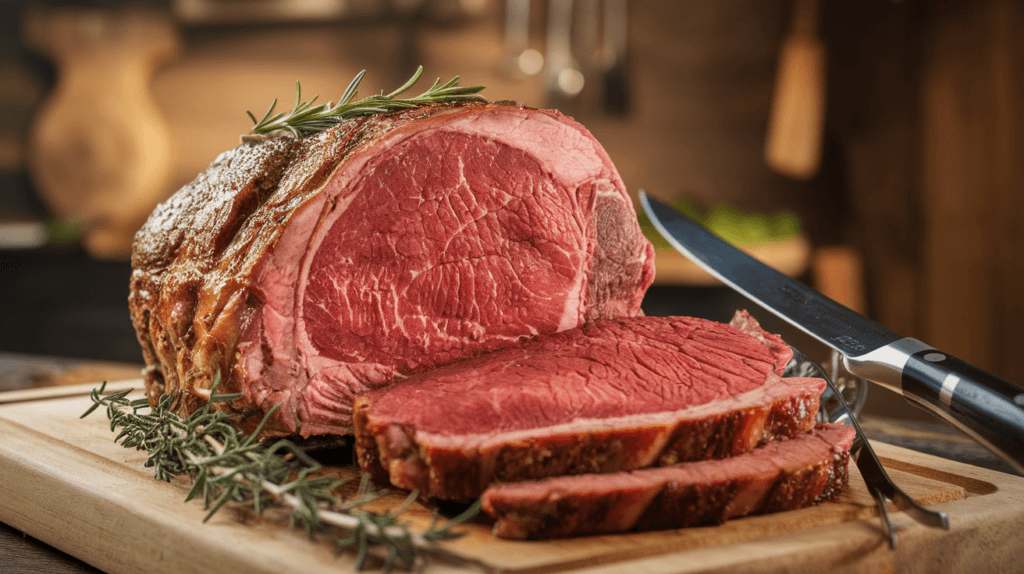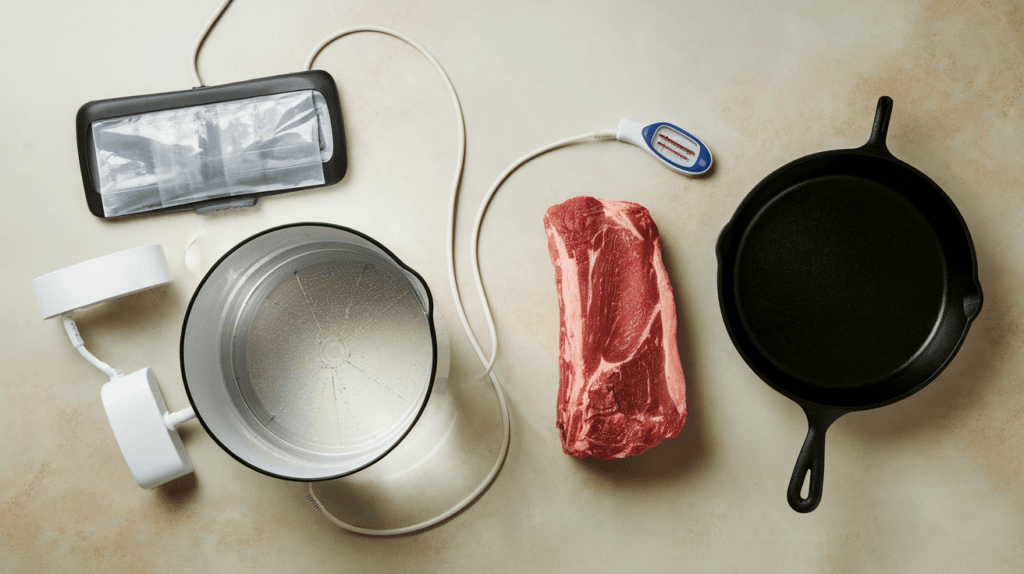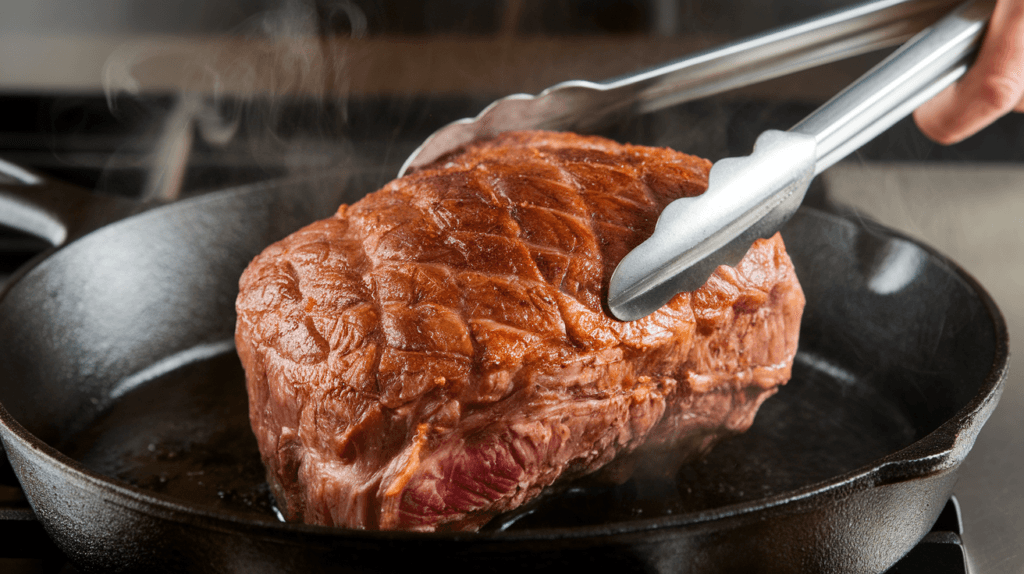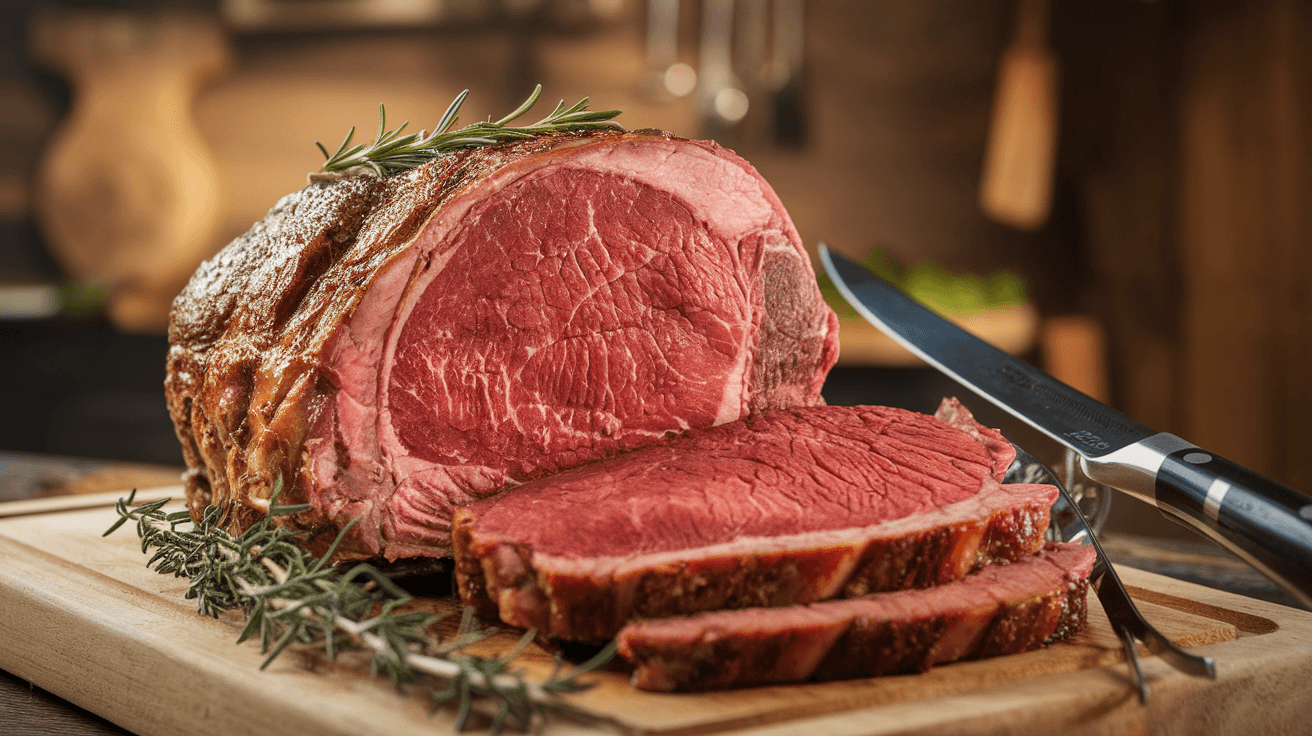Introduction
When it comes to cooking a prime rib to perfection, few methods can compete with the precision and ease of sous vide cooking. This revolutionary technique ensures consistent doneness, maximum tenderness, and incredible flavor in every bite. Whether you’re a seasoned chef or a home cook, mastering the art of sous vide prime rib will elevate your culinary game and impress anyone at your table.

Outline of the Article
- What is Sous Vide Cooking for Prime Rib?
- Why Sous Vide is the Best Method for Cooking Prime Rib
- Must-Have Equipment for Perfect Sous Vide Prime Rib
- How to Cook Prime Rib with Sous Vide: Step-by-Step Guide
- How to Sear Prime Rib After Sous Vide
- Common Mistakes to Avoid
- Serving Suggestions and Pairings
- FAQs about Sous Vide Prime Rib
- Conclusion: Elevate Your Cooking with Sous Vide
Now, let’s dive into the details of how to create the most succulent sous vide prime rib that will make your meal unforgettable!
What is Sous Vide Cooking for Prime Rib?
Sous vide, a French term meaning “under vacuum,” is a cooking technique where food is sealed in an airtight bag and submerged in a water bath set to a precise temperature. This method allows for exceptional control over the cooking process, ensuring perfectly even results every time. Popular among professional chefs and home cooks alike, sous vide is the secret to achieving restaurant-quality dishes with minimal effort.
The Science Behind Sous Vide for Prime Rib
Unlike traditional cooking methods that use direct heat, sous vide relies on water circulation to maintain a constant temperature. This eliminates the risk of overcooking, as the food will never exceed the temperature of the water bath. The result? Juicy, tender meat with enhanced flavor and texture.
Benefits of Sous Vide Cooking
- Precision: Achieve exact doneness every time.
- Consistency: Even cooking from edge to edge.
- Convenience: Hands-off cooking allows you to focus on other tasks.
- Enhanced Flavor: Retains natural juices and prevents moisture loss.
Why Sous Vide is the Best Method for Cooking Prime Rib
Prime rib, known for its rich marbling and exceptional flavor, deserves a cooking method that highlights its natural qualities. Sous vide is ideal for prime rib because it ensures every slice is cooked to perfection, from the center to the edges, without losing its juiciness. Here are some specific reasons why sous vide is the best choice for prime rib:
Perfect Doneness Every Time
Whether you prefer your prime rib rare, medium-rare, or well-done, sous vide guarantees that your desired level of doneness is achieved with pinpoint accuracy. Say goodbye to unevenly cooked meat and hello to perfection.
Retained Juiciness and Tenderness
Traditional cooking methods can lead to moisture loss, leaving your prime rib dry. Sous vide locks in the juices, ensuring every bite is succulent and flavorful.
Stress-Free Cooking
With sous vide, there’s no need to babysit your roast. Simply set the temperature, and let the water bath do the work. This gives you the freedom to prepare side dishes or entertain guests while your prime rib cooks to perfection.
Enhanced Flavor Profiles
The slow, controlled cooking process allows the seasonings to penetrate deeply into the meat, resulting in a more flavorful and aromatic prime rib.
Must-Have Equipment for Perfect Sous Vide Prime Rib

Before you start cooking your sous vide prime rib, it’s important to gather the necessary equipment. Having the right tools ensures a seamless and successful cooking experience.
1. Sous Vide Machine (Immersion Circulator)
This is the heart of sous vide cooking. A sous vide machine maintains the precise temperature of the water bath, ensuring consistent results. Popular brands include Anova, Joule, and Instant Pot sous vide devices.
2. Vacuum Sealer and Bags
A vacuum sealer removes air from the bag, allowing for better heat transfer and preventing the bag from floating in the water bath. If you don’t have a vacuum sealer, high-quality zip-top freezer bags with the water displacement method work as an alternative.
3. Large Container or Pot
A heat-resistant container or a deep pot is needed to hold the water for the sous vide process. Many sous vide enthusiasts prefer insulated containers to maintain temperature stability.
4. Cast Iron Skillet or Torch
After cooking sous vide, a quick sear is essential to create a caramelized crust. A cast iron skillet or a kitchen torch are excellent tools for this step.
5. Meat Thermometer
Although sous vide ensures consistent doneness, a quick temperature check before serving adds an extra layer of assurance for perfect results.
How to Cook Prime Rib with Sous Vide: Step-by-Step Guide
Now that you have your equipment ready, it’s time to prepare your prime rib for sous vide cooking. Follow these steps for a flawless outcome:
Step 1: Prepare the Prime Rib
Start by selecting a high-quality prime rib roast. Trim excess fat, if desired, but leave enough to add flavor during cooking. Pat the meat dry with paper towels.
Step 2: Season Generously
Season the roast liberally with kosher salt, black pepper, garlic powder, and your choice of herbs such as rosemary or thyme. For an extra flavor boost, rub the roast with a mixture of olive oil and minced garlic.
Step 3: Seal the Prime Rib
Place the seasoned prime rib in a vacuum-seal bag or a freezer-safe zip-top bag. If using a zip-top bag, use the water displacement method by slowly lowering the bag into the water bath to push the air out before sealing.
Step 4: Set the Temperature
Preheat your sous vide machine to your desired temperature based on doneness preference:
- Rare: 129°F (54°C)
- Medium-Rare: 135°F (57°C)
- Medium: 145°F (63°C)
- Well-Done: 160°F (71°C)
Step 5: Cook the Prime Rib
Submerge the sealed bag into the water bath and let it cook for 6 to 10 hours. The longer the cooking time, the more tender the meat becomes.
Step 6: Remove and Rest
Once cooked, carefully remove the prime rib from the bag and pat it dry with paper towels. Allow it to rest for a few minutes before searing.
Step 7: Sear for a Crispy Crust
Heat a cast iron skillet until smoking hot and sear the prime rib for 1-2 minutes on each side. Alternatively, use a kitchen torch to achieve a golden-brown crust.
Step 8: Slice and Serve
Slice the prime rib against the grain and serve immediately. Pair it with your favorite sides and enjoy the juicy, flavorful perfection of sous vide cooking.
Perfect Seasoning for Sous Vide Prime Rib
The secret to an unforgettable prime rib lies in the seasoning. While the sous vide method enhances the natural flavors of the meat, proper seasoning takes it to the next level.
Essential Ingredients for Seasoning
- Kosher Salt: Penetrates the meat and enhances its natural taste.
- Freshly Ground Black Pepper: Adds a subtle spice that complements the beefy flavor.
- Garlic: Use minced fresh garlic or garlic powder for a savory kick.
- Herbs: Rosemary, thyme, and oregano work beautifully with prime rib.
- Optional Spices: Paprika, onion powder, or a pinch of cayenne for a unique twist.
Marinating Tips
For an added depth of flavor, consider marinating the prime rib in olive oil, garlic, and herbs for a few hours before cooking. Alternatively, a dry rub with your favorite spices can create a flavorful crust when seared.
How to Sear Prime Rib After Sous Vide

Searing is a crucial step in the sous vide process. It creates the mouthwatering golden-brown crust that enhances the overall flavor and presentation of the prime rib.
Steps to Achieve the Perfect Sear
- Pat the Prime Rib Dry: Moisture on the surface prevents proper browning. Use paper towels to ensure the meat is dry.
- Preheat Your Skillet: Use a cast iron skillet and heat it until smoking hot. This high heat is essential for a quick and even sear.
- Add Oil: Use a high-smoke-point oil, such as avocado or vegetable oil, to prevent burning.
- Sear the Prime Rib: Place the roast in the skillet and sear for 1-2 minutes on each side, including the edges.
- Use a Kitchen Torch (Optional): For hard-to-reach areas, a culinary torch can provide a finishing touch.
Tips for the Best Sear
- Do not overcrowd the pan; this ensures even browning.
- Use a meat thermometer to avoid overcooking during the searing process.
- Let the meat rest for a few minutes after searing to retain its juices.
Common Mistakes to Avoid When Cooking Sous Vide Prime Rib
Even with the precision of sous vide, mistakes can happen. Here’s how to avoid the most common pitfalls:
1. Skipping the Searing Step
A common mistake is skipping the sear, which results in a pale and unappealing roast. Always take the time to develop a crust for the best flavor and texture.
2. Not Drying the Meat Before Searing
Failing to pat the roast dry leads to steaming rather than browning, resulting in a lackluster crust.
3. Overcrowding the Water Bath
If the water bath is overcrowded, the water may not circulate properly, leading to uneven cooking.
4. Using Low-Quality Bags
Cheap or improperly sealed bags can leak, diluting the flavors of the meat. Always use high-quality vacuum-seal bags or sturdy zip-top bags.
5. Ignoring Temperature Accuracy
Precision is key in sous vide cooking. Double-check your sous vide machine’s settings to ensure the correct temperature is maintained throughout.
Serving Suggestions and Pairings for Sous Vide Prime Rib
Once your perfectly cooked roast is seared to perfection, the next step is to create a memorable dining experience. Pairing the rich flavors of the meat with complementary sides and drinks elevates the meal to restaurant-quality.
Perfect Side Dishes
- Garlic Mashed Potatoes: Creamy and buttery, these pair wonderfully with the savory flavors of the prime rib.
- Roasted Vegetables: Carrots, asparagus, or Brussels sprouts roasted with olive oil and herbs provide a fresh, crisp contrast.
- Yorkshire Pudding: A classic accompaniment that soaks up the juices from the prime rib.
- Caesar Salad: A light, crisp salad balances the richness of the meat.
- Au Jus or Horseradish Sauce: Add an extra layer of flavor with a savory jus or tangy horseradish cream.
Wine and Beverage Pairings
- Red Wine: Bold wines like Cabernet Sauvignon or Merlot complement the richness of the meat.
- Craft Beer: A robust stout or porter pairs beautifully with the deep flavors of the prime rib.
- Non-Alcoholic Options: A sparkling apple cider or a flavored water infused with herbs like rosemary adds a refreshing touch.
Plating and Presentation Tips
- Slice the prime rib against the grain to ensure tender bites.
- Arrange the meat on a large platter surrounded by garnishes like fresh herbs or roasted garlic.
- Serve on warm plates to keep the meat at the perfect temperature.
FAQs About Sous Vide Prime Rib
1. How long should I cook prime rib in a sous vide?
The cooking time for sous vide prime rib is typically 6 to 10 hours, depending on the texture you prefer. Longer cooking times result in more tender meat without affecting doneness.
2. Can I cook frozen prime rib with sous vide?
Yes, you can cook a frozen roast using sous vide. Just add an extra 1-2 hours to the cooking time to ensure the meat cooks evenly.
3. Do I need to marinate prime rib before sous vide?
Marinating is optional. While sous vide enhances natural flavors, a marinade or dry rub can add extra depth and complexity to the roast.
4. What temperature should I set for sous vide cooking?
The temperature depends on your preferred doneness:
- Rare: 129°F (54°C)
- Medium-Rare: 135°F (57°C)
- Medium: 145°F (63°C)
- Well-Done: 160°F (71°C)
5. How do I store leftover sous vide prime rib?
Store leftovers in an airtight container in the refrigerator for up to 3 days. Reheat gently using a sous vide bath or in a low oven to maintain juiciness.
6. Can I use the juices from the bag for a sauce?
Absolutely! The juices from the sous vide bag make an excellent base for au jus or gravy. Strain the liquid, simmer it, and season to taste.
Conclusion: Elevate Your Cooking with Sous Vide Prime Rib
Sous vide prime rib is a transformative cooking method for those aiming to deliver a roast that is perfectly cooked, tender, and packed with flavor. The precision and consistency of sous vide ensure an outstanding experience, elevating your culinary results to the next level.
This guide covers everything from choosing the right cut and seasoning to mastering the sous vide technique and achieving a flawless sear. With these tips, you can create a meal that’s both memorable and easy to prepare, perfect for any occasion.
Whether it’s a holiday feast or a casual dinner, sous vide offers stress-free perfection every time. It’s a method that guarantees consistent results and elevates your cooking, making it easier than ever to achieve restaurant-quality outcomes at home. Try it for your next prime rib roast and taste the difference.
Now it’s time to roll up your sleeves, grab your sous vide equipment, and start creating a masterpiece. Bon appétit!

